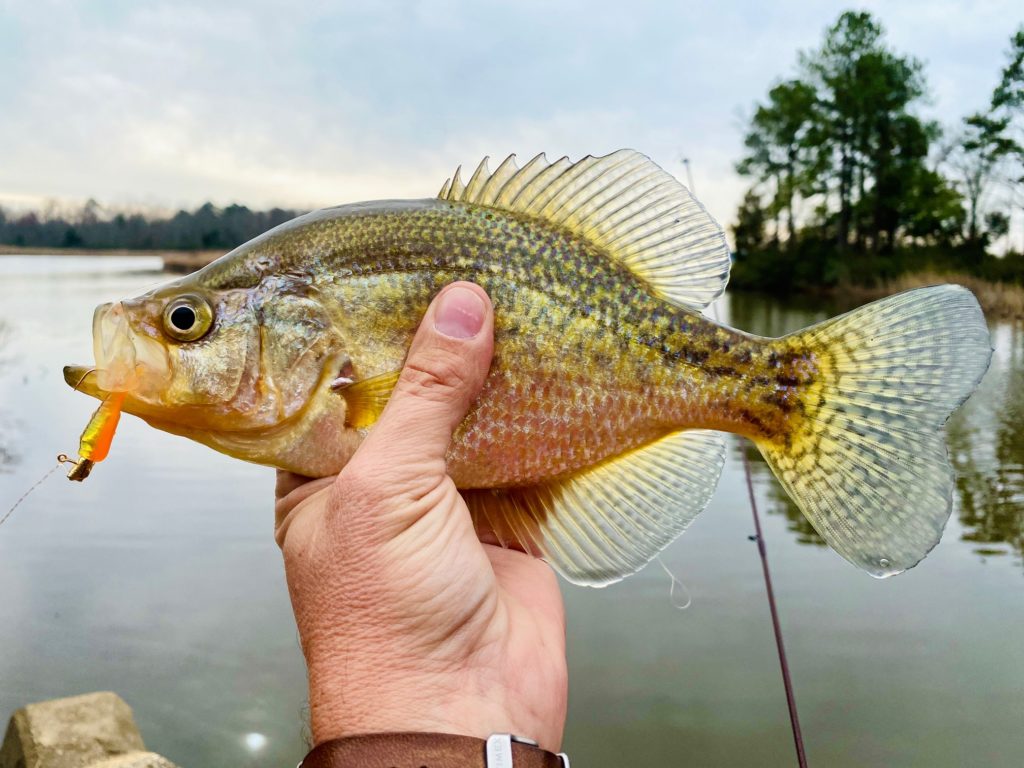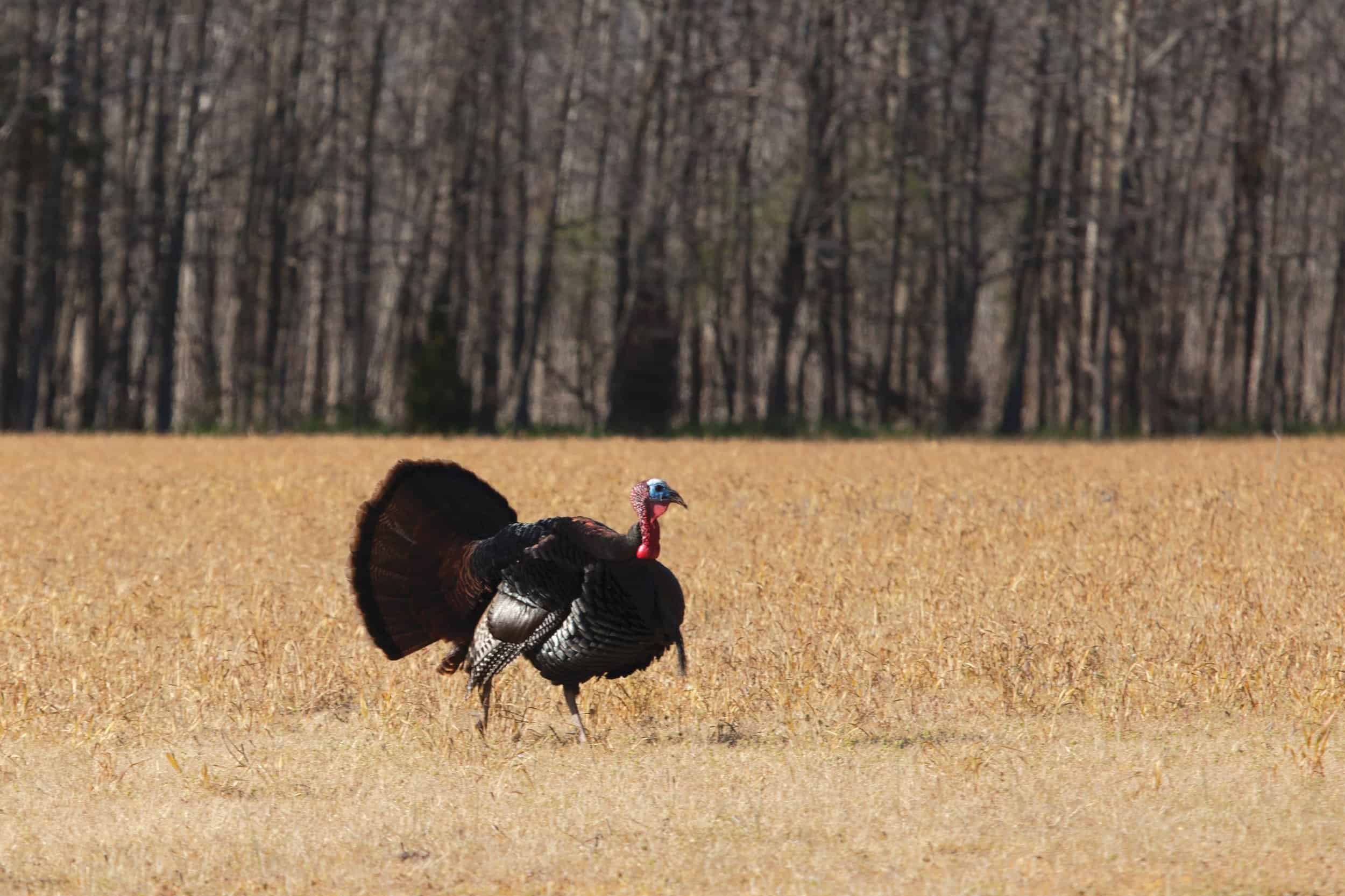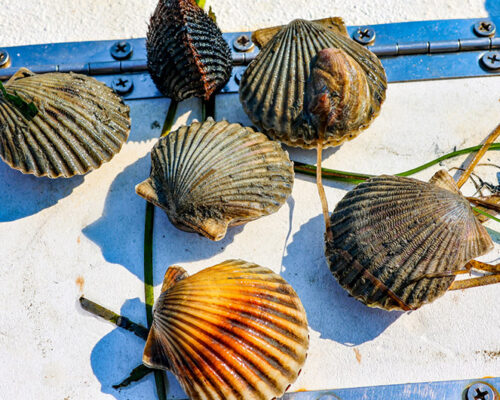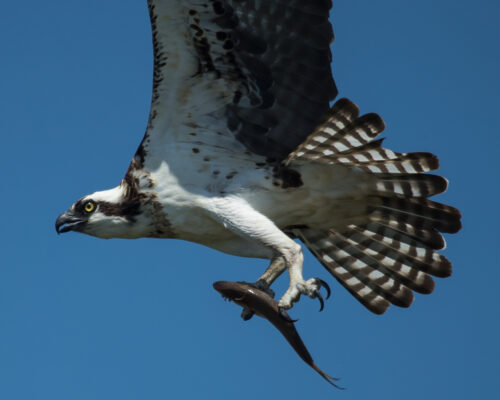Full-bodied and robust, a gorgeous yellow perch, better than 10 inches, burst from the ice-cold water. Solid black bars and green-gold hues dominated the fish’s dorsal flanks, giving way to a magically soft yellow body. At this length—if you believe A.J. McClane’s Guide to Freshwater Fishes in North America, and I do, every word—the fish could be in its fourth or fifth season.
Best of all, this small, little creek that gave up such a beauty was not far at all from my kayak shop at the headwaters of the Corsica River on Maryland’s Eastern Shore. Yellow perch fishing in the Chesapeake’s upper tidal reaches where they spawn heralds the arrival of spring. Experts say the sweet spot in terms of water temps for the yellow perch’s spawning run is 48–54 degrees, and I’ve heard of some keen anglers carrying a thermometer in their fishing vest, but I mostly just go to alleviate boredom. In years when the waters are slow to warm, the fish will spawn primarily based on photoperiod, or the duration or cycle of sunlight.
But you needn’t wait that long to enjoy panfishing. For simplicity’s sake, I’ll lump yellow perch (also called neds or ring perch), bluegills, and crappies together as Chesapeake panfish, which often serve as a gateway gamefish for young anglers, family, and novices. Why? Because the beauty of panfishing rests in its simplicity. You can angle for these tasty fish from countless places along the upper reaches of the Bay’s tidal waters. You can cast from the creek bank, a kayak (or canoe), or jon boat. Chesapeake panfishing is egalitarian in that respect.
Maryland has many well-known perch runs. At the top of the Bay, the deep-water holes in North East and Susquehanna rivers hold fish, as do the feeder tributaries to the Gunpowder and Bush rivers, just to name two. Farther south on the western shore, the Patuxent and Potomac tributaries always hold fish, and therefore draw anglers. The stretch near Wayson’s Corner in the Patuxent, Allen’s Fresh in the upper Wicomico River, and Potomac’s Nanjemoy Creek are proven waters, but don’t be scared to veer off the beaten path. Reliable Eastern Shore spots I like to fish include the Red Bridges, Bowling Brook Creek, and the Tuckahoe, as well as Hillsboro (Tuckahoe) and the upper reaches of the Nanticoke. Many mill ponds and smaller reservoirs hold ample quantities of panfish.
On Virginia’s western shore, look for the same type of waterways to hold panfish. The headwaters of the Pamunkey, Mattaponi, and Chickahominy rivers fish well, as do the feeder creeks to the James and Rappahannock.
“I love fishing for them, and have my whole life,” said Captain Mike Ostrander, owner of Discover the James, which offers wildlife tours out of Richmond. “I’m a white grub guy,” he adds, a reference to his go-to lure. Mike is also the president of the Virginia Anglers Club, which hosts a perch tournament every year.
Simple is good, but be forewarned your lure options can be ridiculously expansive. If you want to fill your creel, there is no better choice than a live bull minnow on a lightweight jighead (1/32–1/8 ounce), painted or not. I like white, pink, or yellow, and prefer deer or marabou hair to dress the jig, but I’ve caught plenty of panfish on naked jigs, especially when the fish are ravenous.
Because I have the attention span of a gnat at times, I like to make a game of how many different lures I can fish to hook a panfish. Here’s a sampling of what I may throw: small spinners (#00 to #1) from Black Martin and Mepps, yellow and white marabou jigs, Worden’s RoosterTails, and Bett’s Mini tube jigs (1/32–1/16 ounce). Small Mister Twister grub tails always have a spot in the tackle box. Local lure makers produce exceptional custom flies and shad darts, and I’m sure your local tackle shop has a great selection of these ned slayers.
As a bonus, chain pickerel and largemouth bass can also be found in the many of these same waters so you’d do well to keep a handful of larger baits on hand. Soft plastic lure options are numerous and include Zoom, Z-Man, Senkos, and Yamamoto.
As for rods and reels, you needn’t get too fancy. In fact, I’d bet dollars to donuts that hand lines would work when the panfish are thick and on the feed. I like St. Croix’s panfish series rods, matched with a 1000 or 2000 size reel that I typically spool with six-pound braid. When fishing in relatively shallow water, monofilament works fine. My fly rod is a 8’6″ five-weight loaded with a sinking tip. Fly patterns, tied on hook sizes that range from #14 to #2, that imitate insects (ants, worms) as well as poppers, Clouser Minnows, and Woolly Worm should work just fine.
After a long waterfowl season, however, I can be as sluggish as a koala on a five-day eucalyptus bender, so I usually prefer a leisurely approach to a day’s outing. All things being equal, I prefer to fish the afternoon of a warmish day or mid-morning on the second day of a two-day warm-up. The caveat, true in all fishing scenarios, is if you wait for idyllic conditions you risk missing out on a good bite. So upload your favorite map to your smartphone (or get out your chart book if you’re old school), pick out a tidal creek, and then pack up the ultralight gear. Chances are the panfish will be waiting.




